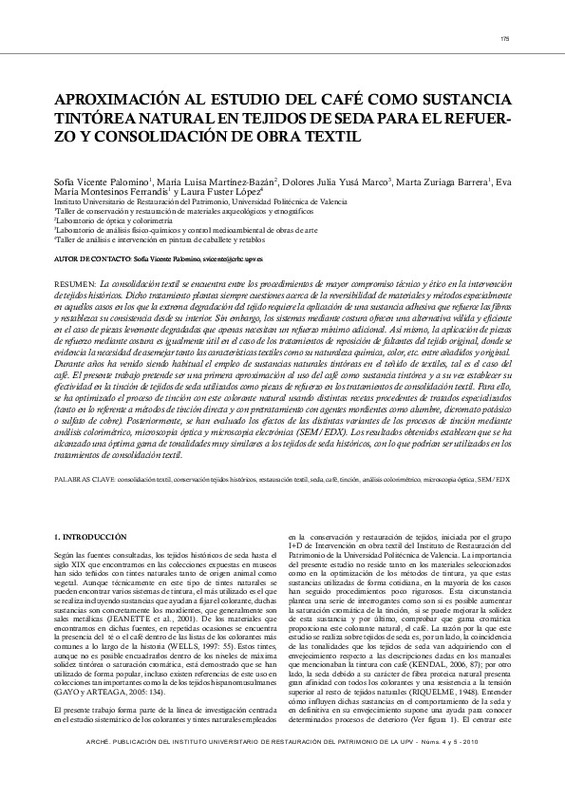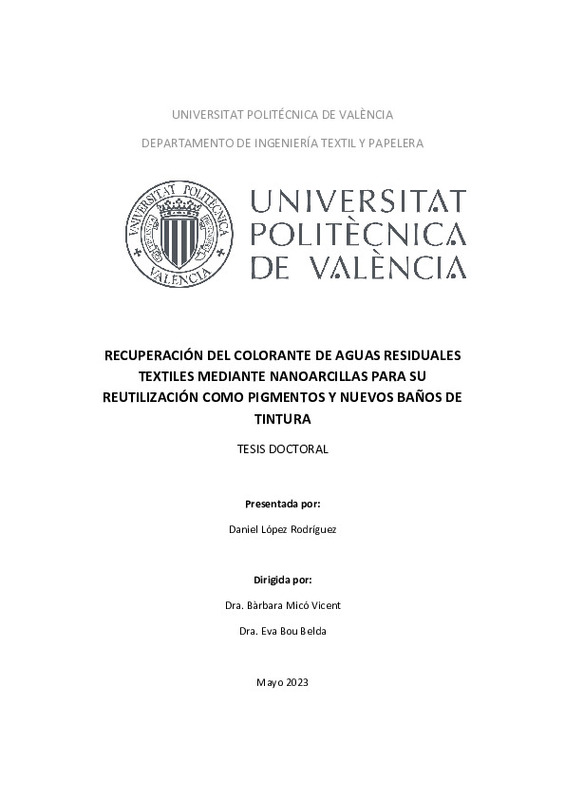JavaScript is disabled for your browser. Some features of this site may not work without it.
Buscar en RiuNet
Listar
Mi cuenta
Estadísticas
Ayuda RiuNet
Admin. UPV
Aproximación al estudio del café como sustancia tintórea natural en tejidos de seda para el refuerzo y consolidación de obra textil
Mostrar el registro sencillo del ítem
Ficheros en el ítem
| dc.contributor.author | Vicente Palomino, Sofía
|
es_ES |
| dc.contributor.author | Martínez Bazán, Mª Luisa
|
es_ES |
| dc.contributor.author | Yusa Marco, Dolores Julia
|
es_ES |
| dc.contributor.author | Zuriaga Barrera, Marta
|
es_ES |
| dc.contributor.author | Montesinos Ferrandis, Eva María
|
es_ES |
| dc.contributor.author | Fuster López, Laura
|
es_ES |
| dc.date.accessioned | 2013-07-08T07:00:08Z | |
| dc.date.available | 2013-07-08T07:00:08Z | |
| dc.date.issued | 2010 | |
| dc.identifier.issn | 1887-3960 | |
| dc.identifier.uri | http://hdl.handle.net/10251/30751 | |
| dc.description.abstract | La consolidación textil se encuentra entre los procedimientos de mayor compromiso técnico y ético en la intervención de tejidos históricos. Dicho tratamiento plantea siempre cuestiones acerca de la reversibilidad de materiales y métodos especialmente en aquellos casos en los que la extrema degradación del tejido requiere la aplicación de una sustancia adhesiva que refuerce las fibras y restablezca su consistencia desde su interior. Sin embargo, los sistemas mediante costura ofrecen una alternativa válida y eficiente en el caso de piezas levemente degradadas que apenas necesitan un refuerzo mínimo adicional. Así mismo, la aplicación de piezas de refuerzo mediante costura es igualmente útil en el caso de los tratamientos de reposición de faltantes del tejido original, donde se evidencia la necesidad de asemejar tanto las características textiles como su naturaleza química, color, etc. entre añadidos y original. Durante años ha venido siendo habitual el empleo de sustancias naturales tintóreas en el teñido de textiles, tal es el caso del café. El presente trabajo pretende ser una primera aproximación al uso del café como sustancia tintórea y a su vez establecer su efectividad en la tinción de tejidos de seda utilizados como piezas de refuerzo en los tratamientos de consolidación textil. Para ello, se ha optimizado el proceso de tinción con este colorante natural usando distintas recetas procedentes de tratados especializados (tanto en lo referente a métodos de tinción directa y con pretratamiento con agentes mordientes como alumbre,m dicromato potásico o sulfato de cobre). Posteriormente, se han evaluado los efectos de las distintas variantes de los procesos de tinción mediante análisis colorimétrico, microscopia óptica y microscopia electrónica (SEM/EDX). Los resultados obtenidos establecen que se ha alcanzado una óptima gama de tonalidades muy similares a los tejidos de seda históricos, con lo que podrían ser utilizados en los tratamientos de consolidación textil. | es_ES |
| dc.description.abstract | Textile consolidation is one of the most technically and ethically awkward procedures in the intervention on ancient fabrics. This treatment always brings up issues about the reversibility of materials and methods, particularly in cases in which the extreme degradation of the fabric requires the application of an adhesive substance to reinforce the fibres and re-establish their consistency from the inside. Sewing systems nevertheless constitute a valid and efficient alternative in the case of slightly deteriorated items that barely need any further minimum reinforcement. Hence, the application of reinforcement pieces by sewing these on is similarly useful in the case of treatments for replacement of missing pieces of the original fabric, where one can see a need for likening both the textile characteristics and their chemical nature, colour, etc. of the items added and the original. The use of natural substances for dyeing fabrics, as is the case of coffee, has been a common practice for years. This work sets out to be a first approach to the use of coffee as a dye and in turn to establish its effectiveness in dyeing silk fabrics used as reinforcement items in textile consolidation processes. This was done by optimising the dyeing process with this natural colorant, using different recipes from specialised treatises (both as regards direct dyeing methods and those applying a pre-treatment with mordant agents such as alum, potassium dichromate or copper sulphate). Later on, the effects of the different variants in the dyeing processes were assessed by means of colorimetric analysis, optical microscopy and electronic microscopy (SEM/EDX). The results obtained establish that an optimum range of tones very similar to historic silk fabrics has been attained, thus meaning that these can be used in textile consolidation treatments. | es_ES |
| dc.format.extent | 6 | es_ES |
| dc.language | Español | es_ES |
| dc.publisher | Instituto Universitario de Restauración del Patrimonio de la UPV | es_ES |
| dc.relation.ispartof | Arché | es_ES |
| dc.rights | Reserva de todos los derechos | es_ES |
| dc.subject | Consolidación textil | es_ES |
| dc.subject | Conservación tejidos históricos | es_ES |
| dc.subject | Restauración textil | es_ES |
| dc.subject | Seda | es_ES |
| dc.subject | Café | es_ES |
| dc.subject | Tinción | es_ES |
| dc.subject | Análisis colorimétrico | es_ES |
| dc.subject | Microscopia óptica | es_ES |
| dc.subject | SEM/EDX | es_ES |
| dc.subject | Textile consolidation | es_ES |
| dc.subject | Conservation of historical fabrics | es_ES |
| dc.subject | Textile restoration | es_ES |
| dc.subject | Silk | es_ES |
| dc.subject | Coffee | es_ES |
| dc.subject | Dyeing | es_ES |
| dc.subject | Colorimetric analysis | es_ES |
| dc.subject | Optical microscopy | es_ES |
| dc.subject.classification | CONSERVACION Y RESTAURACION DE BIENES CULTURALES (UPV) | es_ES |
| dc.title | Aproximación al estudio del café como sustancia tintórea natural en tejidos de seda para el refuerzo y consolidación de obra textil | es_ES |
| dc.title.alternative | An approach to the study of coffee as a natural dyeing substance in silk fabrics for reinforcement and consolidation of textile work | es_ES |
| dc.type | Artículo | es_ES |
| dc.rights.accessRights | Abierto | es_ES |
| dc.contributor.affiliation | Universitat Politècnica de València. Instituto Universitario de Restauración del Patrimonio - Institut Universitari de Restauració del Patrimoni | es_ES |
| dc.description.bibliographicCitation | Vicente Palomino, S.; Martínez Bazán, ML.; Yusa Marco, DJ.; Zuriaga Barrera, M.; Montesinos Ferrandis, EM.; Fuster López, L. (2010). Aproximación al estudio del café como sustancia tintórea natural en tejidos de seda para el refuerzo y consolidación de obra textil. Arché. (4-5):175-180. http://hdl.handle.net/10251/30751 | es_ES |
| dc.description.upvformatpinicio | 175 | es_ES |
| dc.description.upvformatpfin | 180 | es_ES |
| dc.description.issue | 4-5 | es_ES |
| dc.identifier.eissn | 2445-1150 |








